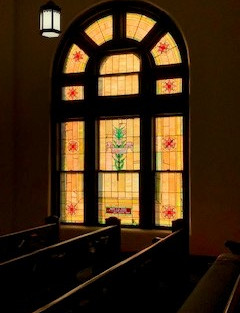Ross Group is passionate about historic rehabilitation projects and bringing old buildings back to life. One of the key ways we do this is by working with a team of experts to maintain historic building features and ensure they are returned to a historically accurate, if not their original, state. For example, on our well-known Tulsa Club renovation, terrazzo was the primary flooring used throughout the building. Despite terrazzo’s durability, years without proper maintenance took a toll. Much of the original 1920s terrazzo was chipped or pitted and had lost its overall finish. We were able to work with our specialty flooring installers to seamlessly match the terrazzo chips, which allowed us to patch the damaged areas and refurbish the existing terrazzo to its original state.

We continue to focus on historic projects and are currently working on restoring the nearly 100-year-old stained glass windows in a Tulsa church. There are 131 stained glass panels with almost 5,500 individual glass pieces, featuring a variety of glass types and colors. As you can imagine, this is a very delicate and detailed process. The easiest option would be to simply remove and replace all the windows with new glass. But Ross Group doesn’t take the easy way out, particularly when it comes to maintaining the history of a building. Project Manager Eric Leisering sat down with us to discuss the historical significance of these windows and what the restoration process will look like.
To begin, the existing, rotting window frames will be replaced to ensure the windows are secure for decades to come. The frames are the original painted wood from the 1920s and are deteriorating, resulting in gaps and leaks. In their current state, the frames also put the windows at risk of falling out. They will be completely replaced with new, Cyprus wood frames, as this material has long-term moisture durability and is a natural insect repellent.
Originally installed between 1925-1928, the windows will undergo a complete restoration by a stained glass specialist. This will include a thorough cleaning of all stained glass panes and replacement of previously repaired, generic panes with stained glass manufactured by the company that originally created the pieces, which fortunately is still in business. Our renovation will maximize both the aesthetics and durability of the windows, resulting in work that will last for at least another 100 years.
The first step in the process is to take profiles of all the windows. An architectural firm was contracted to complete this and determine which elements are original and which have been repaired or replaced over the years. This will allow us to accurately preserve the original windows and replace any more modern pieces with something more historically correct.
The steps below make up a typical stained glass window restoration, which we’re following to complete the project.
The existing windows are removed and sent to the stained glass specialist. Once there, a computer generated template is made for each window, showing where all 131 panels belong.
The windows are placed in a liquid soak for 14-21 days to remove decades of dirt and grime.
All lead is removed and properly disposed of, unbroken glass is set aside for reuse, and broken glass is saved for possible reuse in smaller pieces.
Samples of the glass are sent to the manufacturer – in this case Ross Group is using the same manufacturer who provided the original stained glass panels. The manufacturer then finds the best possible color and texture matches to create any new pieces to replace those that are broken or not original. For our project, they will be using the original, historic process to create the replacement glass.
The windows are reassembled using both the original and replacement glass. For this type of historic job, new lead is specially produced to have a similar profile to the original. However, the new lead will be stronger and reinforced with steel to increase durability.
A thin black cement is forced between the lead and the glass panels to provide extra strength and improved waterproofing.
The windows are cleaned and polished before being returned to the job site and placed in the new frames.

With many historic renovation projects, there are certain guidelines and standards that must be met during the process. For our stained glass project, Ross Group is working with the National Trust for Historic Preservation and the National Park Service. By coordinating with these organizations, we are able to ensure all necessary standards are met and guidelines are complied with throughout the project. This is key to maintaining the building’s historic status.
Something as beautiful as stained glass windows certainly calls attention to a historic building’s past and significance. It’s important to us that this history is always preserved, even when that means taking the difficult path and committing to a long and detailed process. Ross Group is proud to be part of so many historic projects in Oklahoma and across the country, and we continually look forward to new opportunities to restore buildings to their original charm.
If you’re really interested in historic stained glass and the process of restoring it, check out our friends Scottish Stained Glass at www.scottishstainedglass.com and Kokomo Opalescent Glass at https://www.kog.com/!







コメント